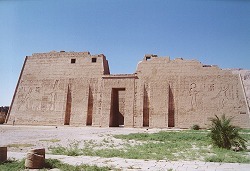
A temple complex on the west bank of the Nile at Thebes, the most imposing of which is the mortuary temple of Ramesses III. The majority of the decoration dates to the reign of this king. In addition to representations of his campaigns and battles against the Libyans and the Sea Peoples, there are extensive scenes of the religious processions of Sokar and Min. A palace is also attached to the temple, and it was here that an attempt was made on the life of Ramesses III. An earlier temple was built at Medinet Habu by Hatshepsut and Tuthmosis III, the complex was also added to after the New Kingdom. In the 25th and 26th Dynasties, a number of tombs were built for the god's wives of Amun (a priestly title for the daughter of the king). The whole complex is surrounded by a mudbrick wall and could therefore provide protection. For this reason the workers who worked on the tombs in the Valley of the Kings, and who used to live in Deir el-Medinah, moved here at the end of the 20th Dynasty. In the Ptolemaic Period, the village of Djeme was even built inside the walls of the complex. According to ancient Egyptian tradition, the tomb of the members of the Ogdoad of Hermopolis was here too, the primeval gods whose role was played out once creation was completed.